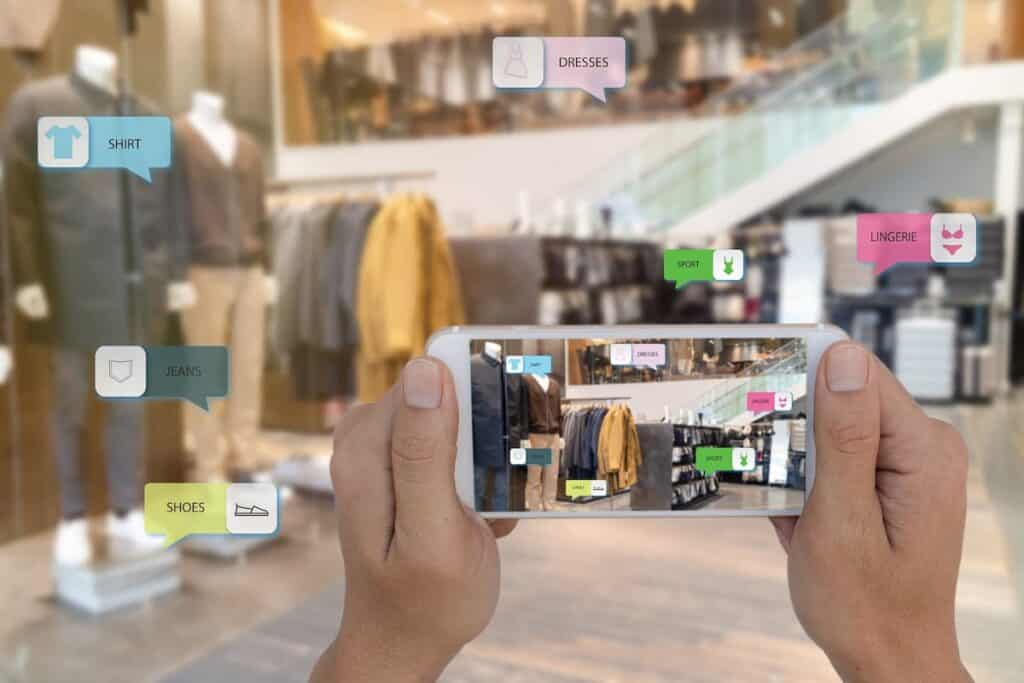AR Advertising Gets into the Marketing Game
Table of contents

Not all of our staff at Nanalyze are highly paid MBAs who graduated top of their class at Wharton. In fact, none of our MBAs are highly paid and half of them can’t even spell Wharton – but we do have a team of MBAs that produce the quality insights you’ve grown to love over the years. Since we spend a lot of time talking to company executives and founders, we do have the odd professional journalist on staff (emphasis on odd), most of whom were inspired to get into the news game thanks to classic movies like All the President’s Men about the Watergate scandal. The reality of the newsroom is something else entirely in most news organizations around the country. News is oftentimes viewed by publishers as the frame for advertising. Digital advertising has changed the game even more dramatically in recent years.

In fact, digital ad spending will outpace traditional media for the first time this year – $129.34 billion versus $109.48 billion. And even that market is quickly evolving, as emerging technologies like augmented reality are used to create AR advertising for video, games, and elsewhere.
Digital Advertising
More and more digital advertising today is what is called programmatic advertising, which simply refers to the fact that software is used to “automate all or parts of the ad buying process.” Beyond that, we know that big data from multiple sources, from web browsing history to social media likes, can be analyzed by artificial intelligence algorithms to deliver personalized marketing messages. Some companies can build demographic profiles for their marketing campaigns using a technique called psychographics. Location data, in particular, is an extremely useful tool for advertisers to learn about our behaviors, hitting us with a mobile ad every time we cruise near a store selling their greasy fried chicken or sweat-shop produced hip hop clothes.
AR Advertising


Blippar claims the engagement rate for web-based AR advertising is 44.8% against an industry average of 2.2%, with users spending more than three minutes per AR experience. This sort of AR advertising still requires the user to initiate engagement with the AR marketing campaign by either downloading an app or clicking on a link. The user must be motivated in some way, which is why many of these AR experiences are gamified, because if people are happy to sling angry birds around on a tiny screen for hours at a time, they’ll explore the back of a cereal box for at least a few minutes.
AR Advertising Growing Quickly
Another type of AR advertising – though it might be better called blended (or mixed or slushied or churned or whatever we’re calling the last blurring of the real and digital worlds) – is one that we came across in our profile on WiMi Hologram Cloud Inc., a Chinese AR company planning to list on U.S. markets. More than 80% of the company’s revenues come from AR advertising services, with a 51% margin last year. That’s better than any AI-powered loan shark. The company’s technology enables advertisers to seamlessly integrate ads into existing video or real-time environments being viewed through an augmented reality app. The insertion of the digital objects into these platforms is so good that the AR holograms do not change their relative positions, even if the device is moved around. The idea is that the AR ad is just part of the existing video or surroundings.
It’s worth mentioning that WiMi is currently operating in the green, with a net profit of about $13 million on nearly $33 million in revenues in 2018. Uber (UBER) lost that much money in the time it took you to read the last paragraph. It’s also worth mentioning that WiMi lists at least four other AR competitors, which isn’t that surprising considering that China is already kicking butt in tech areas like mobile applications, including AI chips for edge devices like smartphones. Being the curious sorts, it got us to wonder whether anyone else is doing this kind of AR advertising outside of the People’s Republic.
In-video Advertising

It’s sort of like Photoshop meets video production meets machine learning meets Mad Men. The use of AI in video editing and creation is certainly a trend we’ve seen recently.
In-app Advertising
A Stockholm-based company working more directly in the AR and VR space is Adverty, which was founded in 2016 and has raised about $4.7 million, including around $3.7 million in a convertible note and venture capital round last October. That same year, the company launched a programmatic ad platform for AR/VR that inserts 2D ads into a 3D environment that are part of the experience. Most of applications are currently targeting games, such as this one that featured a certain cola company that has shown a willingness to embrace emerging tech like AI.
Adverty’s patent-pending algorithms, dubbed BrainImpression, leverage research on human eye anatomy and brain perception to determine when users have fully perceived the ad – only charging clients when there has been a verified interaction between the viewer and the advertisement. There’s some pretty amazing eye-tracking technology if Adverty is staking its revenue on the outcome.
Packaging the Psychology of AR Advertising
Of course, there’s always been a bit of science and psychology applied to the advertising game, as one of the pioneers in the field of advertising psychology once observed: “Man has been called the reasoning animal but he could with greater truthfulness be called the creature of suggestion. He is reasonable, but he is to a greater extent suggestible.” In a study called Layered, about 150 people participated in a bit of brain research that looked at how AR can influence consumer behavior toward brands in advertising. Specifically, the research compared how the brain responded to AR experiences versus non-AR stimuli. The bottom line: AR delivered about twice the amount of levels of visual attention compared to non-AR and, more importantly, participants remembered the marketing message much better, with long-term memory encoding 70% than the usual marketing fodder.

One of the companies behind this research, incidentally, is London-based Zappar, which has raised about $3.8 million. The startup seems to follow the Blippar model, offering a Photoshop-like platform for AR creation that can be used by non-IT geeks who have zero coding experience. Zappar also works on AR advertising campaigns with a variety of clients. One of the more popular applications is AR-enabled product packaging. For instance, it worked with the Shazam app on an AR experience for a new Glenlivet whisky where the distiller appears to talk about the distinctive taste of the booze before you get drunk and play a few interactive games.
The company also offers Zapalytics, a dashboard to track the effectiveness of AR advertising, so PR agencies can justify their outrageous fees.
AR Advertising in eSports


Logos, banners, videos and even interactive objects can be inserted into the gaming landscape. Anzu sees the world’s 2.4 billion gamers as a yet-untapped market for AR advertising.
Conclusion
Indeed, the case can surely be made that the potential for AR advertising is only just now being explored. The psychology says it could work better than the “Where’s the Beef” lady from the 1980s Wendy’s marketing campaign. The sort of AR advertising being developed by companies like Mirriad and Anzu doesn’t necessarily require direct interaction by users, while other forms rely on viewers to opt in to the AR experience, which will remain a harder sell outside of the first-adopter cohort – the types willing to pay for the latest, shiny new tech. With the sort of margins WiMi Hologram has managed to capture, it’s likely we’ll see more startups pop up into this lucrative space, as AR continues to find niche markets outside of enterprise applications, healthcare, and other business applications.
Sign up to our newsletter to get more of our great research delivered straight to your inbox!
Nanalyze Weekly includes useful insights written by our team of underpaid MBAs, research on new disruptive technology stocks flying under the radar, and summaries of our recent research. Always 100% free.














